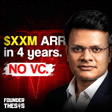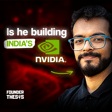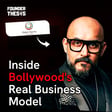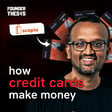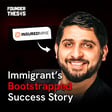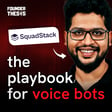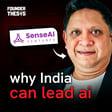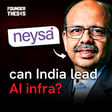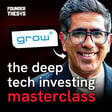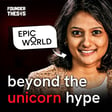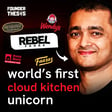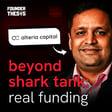Become a Creator today!Start creating today - Share your story with the world!
Start for free
00:00:00
00:00:01

Democratizing Concierge Wealth Management | Ujjwal Jain @ WealthDesk
Most headlines celebrate unicorn valuations of startups, but what we really need to celebrate is when a startup generates a healthy return on investment for its investors and founders. This episode is a celebration of a founder who raised less than 5 mn dollars while building his startup which eventually got acquired for 75 mn dollars.
Know about:-
- Treasury and its importance after 2009 financial crisis
- Choosing a wealth basket for greater diversity
- Platform strategy and customer journey
- Acquisition by PhonePe
Transcript
Introduction to Welldesk and Startup Valuations
00:00:00
Speaker
Hi, my name is Virgil. I am founder of Welldesk.
00:00:15
Speaker
Most news sites celebrate unicorn valuations of startups. But what we really need to celebrate is when a startup generates a healthy return of investment for its investors and founders.
Acquisition of Wealthdesk for $75 Million
00:00:25
Speaker
In this episode of the Founder Thesis Podcast, your host Akshay Dutt is talking with Ujwal Jain, the founder of the fintech startup Wealthdesk.
00:00:33
Speaker
This episode is a celebration of a founder who raised less than $5 million and got acquired by a major fintech unicorn for $75 million.
Connecting Investors with Advisors
00:00:43
Speaker
Wealthdesk is one of its kind platform that, on the one hand, helps retail investors to access high-quality advice and, on the other hand, allows financial advisors to scale up their revenues. Listen on, and if you like such insightful conversations with disruptive startup founders, then do subscribe to the Founder Thesis podcast on any audio streaming app.
Ujwal Jain's Early Interests
00:01:10
Speaker
So I did my engineering in computer science, and I was always fascinated about working in computer science and capital markets, because at the seeds of that interest or progress was so on way back when I was in school, when I used to look at markets, because my father used to train a lot, and I used to see how market prices went from back pages of newspaper to news feeds on news channels, and then to one hour for file force. So I always looked at technologies driving out of that field, and I started programming in very early class seven,
00:01:40
Speaker
seventh grade. So I was clear that I want to take up science and do and finally get a computer science seat in engineering and then eventually join a capital market focus with this. So that clarity was coming up gradually. Obviously, it was not that clear. But that didn't cause becoming clear, the passion was coming out well.
Role at Deesha and Treasury Management
00:01:56
Speaker
So after my engineering, I joined Wall Street hedge fund, Deesha. Fortunately, it's run by computer scientists. So Deesha is one of the technologically advanced hedge fund based out of New York. So I was fortunate enough to join that.
00:02:08
Speaker
hedge fund, which completely run with a computer-sized mindset, trying to make fund management to a Western relationship. And I was part of the Treasury team there, and we were building, we ended up building. In a post-prisis one, Treasury became a very critical function. So I was involved building the core Treasury Council, which has a renewed focus post-financial crisis in 2009. That's when I enjoyed. What is Treasury and why did it become important, post-financial crisis?
00:02:32
Speaker
So most of the hedge firms actually, they trade in markets in their different fund structure through prime brokers. And prime brokers are very dedicated. There's a very comprehensive margin agreement around which their portfolios are margin in the sense how much money you need to put to trade a particular instrument. So this prime brokerage agreement, which are called margin, counterparty margin agreements,
00:02:53
Speaker
These are modelled by Prime Brokers because they are taking the risk of the funds instrumented portfolio. So what Smart hedge fund does is make a typical of DSHAs scale. They also mimic this margin increment that they are in. So then they know their incremental capital cost when they are trading with these Prime Brokers or when they are through this Prime Brokers when they route their training, their security. So they know what is the incremental capital they have to deploy. And that becomes a very critical function to create and the strategy level and the fund management level.
00:03:21
Speaker
What is the need for a margin? If I buy a stock, then that money is going out from my account. Now, if I buy, let's say $1 million worth of Twitter stock, $1 million goes out from my account. What is this margin? No, no, no. So typically in a prime brokerage relationship, especially with the hedge fund, when you buy a $1 million worth of stock, you need not buy and give $1 million. So you can put, let's say, X-puss it and the remaining is funded by the broker.
00:03:44
Speaker
And we are just talking about here, you are just talking about Twitter, imagine complex listed options, futures, over the counter securities, which are modeled synthetically, margining for these are very complex. For example, you can hedge US portfolio when let's say one of the developing economies portfolio, so that hedging will give you capital advantage from a margining point of view. So globally hedge funds have very complex margin agreements with their counterparties when even
00:04:08
Speaker
margin of these portfolios, you give it a global level. And the prime brokers ensure the regulatory margin requirement in different exchanges. For example, there's something called SPAN margin. It's a regulatory requirement to put it at the exchange level for individual accounts and whichever account is changing. So all of that, prime brokers take care for a hedge fund prime broker regulation. So as a hedge fund, what you do is you try to optimize your capital when you're investing, because then use leverage also as a very important factor to create alpha.
00:04:37
Speaker
So just explaining with an example, like if I can get exposure to 1 million of Twitter stock by just putting in $100,000, then my return on that $100,000 will be much higher because if Twitter moves by 1%, that 1% will become 10x because I am just putting one tenth of that 1 million. So which is why this is important for a hedge fund.
00:04:59
Speaker
Correct.
Insights from Bombay and JV with Reliance
00:05:01
Speaker
And hedge funds, when they build their strategies, leverage is one important factor because for a limited investment amount, mitigating their risk across all portfolios, they amplify their returns by using leverage very innocently. And prime brokers provide that services by bringing complex margin agreements which you can use to fund these portfolios. And that is managed by 20 years. So it sits at the middle of the front office, middle of his background.
00:05:25
Speaker
And post prices became important because prime brokers were going through the liquidity crisis, right? So they wanted to increase margins and all that. But if your agreements are well, sort of on what margin they should expect, you can reconcile well and you are at the, you can still continue to protect your capital. So it becomes important. So interestingly, after 2000 President RCCM, the entity got sponsored from Disha, where they independently opened this treasury platform for other experts.
00:05:50
Speaker
So imagine how technology can advance these funds and resource that they ended up creating a new business as a technology with this platform business for providing treasury platform with others. So I was part of that culture. This would have been part of like a SaaS business. Yes. Yes. If you go and look at RCCM, it's a platform service to other engineers. Now within DSHAR, there was an opportunity to actually move to Bombay for where the DSHAR was going into JV with their lines industries.
00:06:17
Speaker
where the idea was to deploy and manage treasury money with desires for management expertise into Indian markets. That's when I came to Bombay. First, we used to do prop trading, then we ended up doing institutional profit with this. And that's when I got excited for predating on this and using the treasury capital to deploy markets across different strategies.
00:06:35
Speaker
And that is the time when actually I got exposed to Indian capital markets as a professional, like knowing Indian markets so closely from a business standpoint. And that's when my sense was that there's a massive market opportunity in India to build as a computer science guy to create businesses, whether it is proprietary trading, whether it is brokerage business, whether it has
00:06:53
Speaker
But whatever it is, it is a very good play. And not just B2C, even B2B also, you can do real things. So that was the confidence I got when I booked an Indian markets portfolio. And in between, we used that the jail was shut down for some reasons. And then I was asked to move back to the treasury platform business which we spawned up. But I decided to stay back in Bombay.
Technology Behind Wealthdesk
00:07:13
Speaker
And again, a fortunate moment for is where I got immediately I got an opportunity with the MSCI, the other leading index provider in the world. So they actually...
00:07:22
Speaker
Yeah. Now it is called MSA only. So they are the leading index providers. And index business is very different from hedge fund business. So hedge funds are very actively managed portfolios. While if you are building an index, you are passively creating an old-based strategy, tracking an index, which can be used by anyone to create ETS. For example, iShares, landlords of the world do it.
00:07:43
Speaker
So I saw that there's a good opportunity to look at passive side. But again, passive businesses, especially index-hand businesses, are again very heavily on tech because you are building everything on a technology platform, the rules engines, everything runs on technology. So I joined that business and I got exposed to passive business. Fortunately, I was part of launching some of the most modern, sophisticated industries around factor investing, smart beta, carbon credits, no ESG indices at all.
00:08:09
Speaker
Does MSCI offer indices on Indian market or are these for global market products? Like in India, it's NSC 500 BSC. These are the indices, right? Correct. So actually, MSCI has a global index in which India index is also part of that. So that's what Jimmy index. If you look at all the passive money globally that gets put deployed into Indian market, most of them comes to MSCI index only, which is tracking India.
00:08:35
Speaker
at a global level. So that's the global part of it. The Indian part of it, I think custom Indian indices has been launched by MSA, but not that big because NSC, BSC predominantly drive that market, especially AMCs tend to open launch for the exchange indices right now, because they are well known and good domestic you around Indian markets. Recognize brands.
00:08:56
Speaker
Yeah. So when I was in MSA, that's when I actually started making Indian brokers and management firms, EMCs and tried to understand the Indian landscape, like what could be done with a very long term view because there's a massive market opportunity. Not just the short term, but the long term, you can build great, but this is all of India, competitive technology led. And interestingly, at that point, I saw some great shoes. One is that Ziroda was driving the entire booking.
00:09:21
Speaker
which was a completely different perspective of how a broker in a Bombay would cook like versus how Zerotha was doing it. I could send that from a computer-sized mindset. The second was SEBI came up with their first recognition around investment advisory in 2013, which was around driving a product distribution in India under advisory model versus distribution model. But just to give you some sense, what it means is that if you buy a mutual fund or invest in a stock, you most likely you will not, don't pay anything for that because there's some commission that
00:09:49
Speaker
the distributor is getting in the back end. So, there is a fiscal distribution model.
Advisory vs Traditional Models
00:09:54
Speaker
For instance, if I send you that I will recommend you this product or I will provide value in your account, you pay me a fee, but I won't make any money on the day-in side or the commission side. So, that transition or that phase started with the RE recognition. We have said it was clear that eventually in the client interest advisory should scale up faster that distribution in India and largely even today, there is a past bucket run by under distribution model versus advisory.
00:10:18
Speaker
So I realize that mutual funds will continue to penetrate under a distribution model because penetration itself is the problem. One quick recap. The distribution model, funnily, these people who are distributed are called financial advisors, right? Yeah. So I just wanted to clarify that for the listeners. So when you buy mutual funds through a financial advisor, which means like it could be a bank employee or someone you know, then
00:10:41
Speaker
He is earning some commission, which is not transparent. You are not aware of it. Whereas in the advisory model, there is a money manager. Say it could also be an app. I'm sure there could be some apps which charge you a fixed amount. I think ET money has this now. They've lost the product here. So they charge an amount of fees for giving you the right advice on what to invest in and giving you updated advice on a regular basis. And do they also provide execution support or they just are an advisor?
00:11:10
Speaker
No, so you can provide as part of your advisory, you can provide execution support, but there has to be a very non-construct way of making money from the customer. So on one side, the transparency should be there, there should not be some
00:11:23
Speaker
It's completely disproved. So I realized that while mutual fund penetration is the problem, so distribution is key, so it will continue to expand. While if I look at a 5-10 year view, there's a massive opportunity to build a technology stack, wherein on one side, you bring in advisors who can create portfolios for different demographics, investment strategies and all, and market segments. And on the distribution side, if you could extend how an open broking would look like, where you can integrate with a broker's training app,
00:11:51
Speaker
If you interconnect this entire value chip from product creation to the execution in the client account, we are talking about parallel to mutual fund, a different investment instrument available to retail investor and advisory, which is going to put only what we call as well baskets. So that technology we started building back also where I quit my job in 2016 March, I started building it from 2016 onwards. And in 2018, we first closed the platform. So what we are essentially the platform, we are a B2B2C platform.
00:12:20
Speaker
But the B2B, we have a portfolio manager who can manage portfolio, who can do advisory and research. They come, they create platform portfolios of our wireless business platform, it's a SaaS platform. And on the distribution side, what we do, we open this consumer channel inside the broker's app or even outside also where you can log in with the broker.
00:12:38
Speaker
where customers can discover these portfolios at their advisory and more research model, and they can pay a fee and invest in these portfolios. And this model puts so new category is something which we have enabled in the V2-V2 segment. So parallel to mutual funds and PMAs at their advisory, for the first time, retail investors can get into various portfolios on broking.
00:12:57
Speaker
So, the shift at the broking level is like this. When you open a broking account or when you're an existing broking customer, most likely you do transactional, you invest in stocks at different times and exit. Typically, most of the people are not very versed when to enter, when to exit specific stocks and time the market, right? What happens is after a point, they end up exiting the winners very quickly or having losers for a long time. And that's why most of the broking accounts
00:13:22
Speaker
especially investors, they get dormant after a while because they burn their fingers because they don't know how to make systematically money. But the same customer would have done reasonably well in virtual fund space because he invested in the right sort of management, smart fund manager. So on broking for the first time, if you work with this manager,
00:13:37
Speaker
or a mundane investor what is happening is that the same customer who was instead of fighting straws investing in managed portfolios which are managed by people who know how to do it and replicate the underlying portfolio still in their own working count so they know more the underlying stock which they want to do but and gradually in that portfolio whenever there is a change manager makes it you get the update
00:13:56
Speaker
one touch of one bias to do it and systematically you are getting into a portfolio based investing strategy in broking. That is very important in India because as broking gets commoditized and gets to a larger retail property, it is very important to create a category of investing in the broking so that the people eventually make wealth systematically like they move on to your firm because
00:14:17
Speaker
If you look at the international segment, PMS, these are the portfolio-based strategies, which is only available for 15 lakh, 1 crore plus ticket-sized customers. Retail investors cannot have that product because they can't have that much of capital to deploy. Imagine democratizing that capability with that kind of offering at a retail investor level through
00:14:38
Speaker
That is what we are powering. And because of platform play, you can scale this at a very effective way and make sure super little solutions are available to retain in the store. So that's the vision we are working in building this platform. Okay. So let me again break it down a bit. So what you're saying is that most.
00:14:57
Speaker
investors who open a Zerona account end up becoming inactive after a couple of months because they are not professional investors and so they will face some loss because of which they will get demotivated and they go inactive after some duration. So really like that retail, that retail level investment is not a mass market product. It's for people who have the time and the patience to learn, study and continuously follow news about stocks so on and so forth.
00:15:22
Speaker
And for people who make money, there are people who are H&Is who use a portfolio manager who is able to do all this work of tracking stocks and deciding what to buy, when to buy, what to sell, when to sell, and so on and so forth. So you have made it possible for a regular retail investor who's not an H&I to get access to that kind of sophisticated portfolio manager who is constantly researching and taking decisions about what to buy, what to sell, when to buy, when to sell, and so forth.
00:15:50
Speaker
And the way you're doing this is the advisor, the portfolio manager can create a model portfolio on Welldesk and he can continuously update that model portfolio and that gets connected. And as a retail investor, I can subscribe to any of the model portfolios available there. Maybe these model portfolios could be based around some theme like it could be, for example, tech or digital or so on and so forth.
00:16:17
Speaker
So based on the theme, based on the reputation of the portfolio manager, I could subscribe to a particular portfolio and therefore then it becomes passive investing for me. It is almost like investing in a mutual fund because in a mutual fund also it's the same. You put in money and a mutual fund manager is doing that. But here there is more flexibility or like what is the difference between investing in a mutual fund and investing in a or subscribing to a portfolio from a well-desk portfolio manager.
00:16:46
Speaker
Yeah, so for a well-passed kid, if you invest in a modern pool studio or a well-passed kid, the fact is the underlying stock stays with you in
Transparency Through Wealth Baskets
00:16:53
Speaker
your booking account. So you have complete transparency of the underlying stocks, which is, and you, while in case of mutual fund, you invest in the fund, while the underlying constituent, you get to see the disposes every month. But you are investing in that fund. While you're not broking, your objective is to get directly exposure to these companies.
00:17:08
Speaker
So model portfolio and well basket ensures that continue to follow fund structure or a portfolio structure but the underlying stocks are with you in your demand account. So that's one thing. So complete that. That's just a technical difference. As in in vessel, the color of money is green always. It doesn't matter.
00:17:26
Speaker
Yeah, so the other thing is that the other important thing is that you, so for the kind of portfolio accessibility through a modern portfolio version of mutual fund actually are very different. So for example, today, when we look at and people say, should I do wealth baskets or mutual funds, or should I do both? The idea is very simple. You continue to do your mutual fund.
00:17:43
Speaker
But you open a brooding convinced of investment objectives, right? You want to get exposure to some specific sectors, or stocks or segments for which you might not be an equity and mutual fund also. So for these nuanced exposure, what people are doing is they are investing in these managed portfolios of smart managers are all getting, as you rightly said, tech, digital. So these are semantics, even some sectoral sectors. And this one interesting thing we are seeing is ETF investing.
00:18:08
Speaker
So, if you look at individual ETFs like an 50-50 ETF or an index 50 or a mid-cap or a US ETF like a NAS type or an S&P, individual ETFs, you can go and invest and track money on deployment and that it is all working. But with the same ETFs gets into different well-passed kits around, let's say, you want to create a portfolio on India, US, on gold and equity. Those varying schemes depend smart marriages. When you get portfolios,
00:18:33
Speaker
The underlying ETFs are scientifically weighted and defending different market conditions, the weight keeps changing, tensioning in the right way, keeping the macro economy and micro economy as what manager decides. You tend to outperform the individual ETFs performance and that is a very interesting and we are seeing that ETFs and baskets are creating a new
00:18:52
Speaker
portfolio construction strategy available in a retail investment level using the simple UTS which can create strategic wealth for you at a very nominal cost. So those kind of stuff you can use a parallel to mutual fund. So in the overall investment integration of the retail investors, you open a broken account to get exposure to stocks UTS. Instead of doing directory video, you are not smart enough to follow till the end.
00:19:13
Speaker
getting this managed to do it the right way. While you continue to invest in a future fund for a long term strategy, like some of the funds that you go according to the vendor. So it's a, it's a more interesting market. And the other thing is, the liquidity wise, you can withdraw money from these web baskets anytime. So real time redemption is there. So always there for you. So that flexibility is always there.
00:19:32
Speaker
Okay. So there is this concept called portfolio theory, which basically says that investing in multiple non-correlated set of assets will earn you more in the long term than just doubling down on one single asset. Like you invest in a company which makes umbrellas and you also invest in a company which makes caps. On sunny days, caps will sell, on rainy days, umbrellas will sell. So you are diversifying. So the same thing now you're saying is the reason why somebody would choose a wealth basket for more diversity.
00:20:02
Speaker
Whereas a traditional mutual fund will, say, offer you only exposure to India or more generically, say, mid-cap or small cap and so on. But in the wealth basket, you could get something which is exposing you to, say, India and US, as you said, or India equity plus commodity like gold, you give an example. So that is something which can give you more benefits in the long term. So that is one reason. And the second reason is mutual funds
00:20:30
Speaker
You cannot have, say, thousands of mutual funds around different themes, but you can have thousands of wealth baskets around different themes. Somebody was to just say that, okay, I believe insurance is the next big thing. So you can have a wealth basket which is around insurance only, but you can't have a mutual fund which is focused on insurance. So that long-tail, more options, that is the other thing which basket gives.
00:20:51
Speaker
Correct, because their mutual funds are created with a very larger objective to create mass retail product. So, if when it comes to concentrated exposure, nuanced exposure or very innovative portfolios that can come through went baskets and one other trend that we are seeing on our platform, the PM is from who were only ticket serving the encourage in the H&I segment of family offices.
00:21:12
Speaker
They are realizing there's a mass effort retained building up and they can't access 50 like one road but still they can manage a smaller ticket size portfolio. So these premium managers are now coming to retail because through platform they can open these smart portfolios to retail investor. And that is a deprecation in true sense where you are bringing significantly better
00:21:31
Speaker
When put portfolios to the retail investor, so that retail investors wants it, but he cannot access it. No, he can access it because the ticket size. So that is also for a like a talented portfolio manager. The previous option was to focus on big ticket.
00:21:47
Speaker
or like the big fish because you earn more there. Like you would rather want somebody who can give you one crore than somebody who will give you one lakh because you earn more there. But with this product, by creating portfolio and wealth basket, he can actually get 1000 investors who are each putting in one lakh each because he doesn't need to personally do the servicing. That client servicing can do time investment. It is completely gone now. Okay.
00:22:14
Speaker
Springa Heavy Lifting is done by the platform to facilitate this entire language chain. On both sides, it's integrated and it is one regulated entity who is creating the portfolio, the other integrated entity which is executing the client's account. So, all they are interconnected in an interoperable tech. And actually, if you look at our current vision, what we are calling ourselves as the unified Melz interface for proper broguing slash transactant platform. We are bringing all these stakeholders into an interoperable tech layer.
00:22:39
Speaker
One party is doing portfolio construction or they are the value creators and the other party is ensuring that value goes into your account. And this entire pipe is what we are building as a platform in India. What are the assets covered under wealth baskets? You said exposure to gold. How would that happen?
Future Plans for Mutual Funds Integration
00:22:54
Speaker
So gold ETFs. Okay. Gold ETFs. Okay.
00:22:57
Speaker
Yeah, right now the instruments are telling assets on which the manager can create portfolios, stocks and ETFs. We are in the process to even bringing, by the way, mutual funds also in next year, where you can package mutual funds, well baskets also. Because there is a reason for that. If you look at the inter-HNI segment, most of the
00:23:17
Speaker
A guy with a huge amount of purpose, when they invest, right? Even the mutual funds have not looked at the isolation. You look at a bunch of mutual funds with defined weights at the overall asset allocation. Retail investors look at 10 rupees at the individual interest funds. He might end up doing a tax favour, he might do a large cap, he might end up doing a big cap, or without any significant reason, with a significant reason also in some places.
00:23:40
Speaker
So what idea is then, even these advisors can package these mutual funds also in a very scientific way for different investment objectives and open it to retail investors. So that also becomes a web basket. So packaging means what the web basket is about what you rightly said is to bring that multi-assent value to the retail investor with efficient execution, which is a very heavy problem to solve, large and complex problem. But that's the journey we are going through as a platform.
00:24:04
Speaker
I would have thought mutual fund would be easy to do. There are so many apps offering you to sale purchase of mutual fund and all. Like why is mutual fund coming in so late? Actually, good point. Actually, at some point if I would have started packaging platform technology to package mutual funds, bunch of mutual funds and to portfolio and open it to the internet, it was an easier problem to solve.
00:24:25
Speaker
the difficult problem because advisory rate portfolio construction at retail investor using direct stocks and India was a challenging and it was a very critical need of the market when it comes approaching account you are talking about direct stock and medium exposure so important to bring that and then mutual fund. So mutual fund is not a challenge it's a journey.
00:24:43
Speaker
which will bring him down. Got it. Mutual fund is very me too. If you would have started with that, you would have been facing companies like, say, Deserve and all these which have raised a fair amount of funding and all of that. Such companies are actually not our partner, they are actually our partner because he has a platform enabler. We work with every stakeholder in the country. On the manager side, on the execution side. So, technically, all our partners. How is Deserve your partner?
00:25:09
Speaker
So technically, Deserve can actually, for example, Deserve or Forhead, any other mutual fund platforms can come now on a plug-in, they can package portfolios and open it to their investor and they focus on their core competency images, portfolio conception, asset allocation and all that. So as a platform, we are trying to become heavy lifters of this entire brand new chip and each particle has its own mutual exclusive strengths.
00:25:31
Speaker
and join them, which means that everybody is your partner. No, but Deserve is doing both, right? They are acquiring customers on the one hand, so they are building that capability plus they are saying we will manage your wealth for you. What part are you saying? Like you're saying that they will offer wealth management to more people or they will allow their customers to
00:25:49
Speaker
For example, this would be that, let's say they hold an RAI license, assuming they can continue to acquire a channel independently through their own network, for example, a company like this. But they can acquire more customers through... No, to the network. Even the same is fundamental to platform services, right? The portfolio managers, you know, platform will open their advisory portfolios. There's a never expecting distribution channel being created because we are indicating this is every device available through broken partnerships. So on board, it's like,
00:26:16
Speaker
When a seller comes on Amazon, he doesn't need to care about time. He can serve only Mumbai and Maharashtra, for example. He can serve the entire country. So that's why the network effect is something which is cool to our business model. Got it. What about exposure to global markets? Say exposure to US market and all?
00:26:31
Speaker
So right now we have realized that there's a lot of good stuff happening to open global markets to retail investors in a very frictionless and at a cost-effective way. That's a very important part when it comes to retailizing global markets to Indian investors. So as that happens, which is a matter of time, it's happening, even the good part is give cities with open depository receipts that you can easily invest through existing broken channels.
00:26:54
Speaker
So, that's a journey which is happening on the conventional side. What we are eventually right now focusing is that most of the critical global exposure can be very well done even today with ETFs. And when mutual funds come, they already have freedom funds, right? So, that's the journey how we take it. But eventually, let's say go to efficiently low cost, section less way of exposing directly to stocks and ETFs in global markets, we will open that channel as in when the market is right.
00:27:34
Speaker
Right now, what you can offer is only something which a customer can buy on a Zeroda or any of the broken apps. Right now, these apps don't offer people to, for example, directly buy a Twitter stock. Therefore, you cannot really offer that as an asset class. But that is in process. It will eventually
00:27:43
Speaker
You're saying currently you can get global exposure through ETF. How is that?
00:27:54
Speaker
That is not even we can directly integrate with somebody who opens global markets. But we are not taking that path because even with that journey, there is a cost, there is restriction. There is a point doing something just for the sake of doing, right? We need to do it. It's not mainstream yet. I think you can get the right asset allocation exposure. See, leave that running rush of that, okay, I need to hold a test stop or a test stop. But say that I need to have exposure, which takes stops. There is a way to do that with the current universe. So that's what we are looking at.
00:28:23
Speaker
And managers understand that. So they believe in that model. Now you said the fundamental advisory model is you pay a fixed fees. How does that money transfer happen from the, from a user to a portfolio manager who's created a model portfolio on well tasks. There are two touch points. So one is the manager connects fee or the portfolio when you invest. So that connects correction happened directly from the customer to the manager.
00:28:52
Speaker
Okay. Which means he's telling his existing customers that I have created this way for you to subscribe to my services. Just pay me and you can subscribe through zero. That probably there'll be some coupon code or something, which he will give to his customers. Or how will it happen? Yeah. Like you want to promote more at a very cost effective. So that's a campaign
Integration with Brokers
00:29:10
Speaker
part of it. But yeah, the fee connection happens from the customer to the manager. And then you invest with that. But only like, how would you do it? So with the broker in that delay portfolio, by putting the booking account and executing the booking.
00:29:22
Speaker
So that is one way direct collection. What is the other way? If a Zeroda user discovers this concept and wants to subscribe to a portfolio.
00:29:31
Speaker
Yeah, so our platform strategy is very simple. So as a manager, when you come and create your portfolio, there are three channels. One is on a broken app, your customers can discover these portfolios. Broken customers can discover these portfolios by inside the broker's app and they can invest, pay a fee and invest in these portfolios. They will pay the fees to wellness. How is that fees? Fee directly to the manager through the payment division. There's a flow through which they pay directly to the manager.
00:29:56
Speaker
Okay. Okay. So you're not coming in between there, but if zero does it take, yeah, we are a service provider in that band-aid chip. So we enable those gateways and all that, but the whole is like my customer pays to the manager. So just to clarify, first way is that inside the broker's app, your portfolio gets discovered and customer can invest in it. The second is like a Shopify. We opened a direct consumer sites.
00:30:18
Speaker
as a enabler for the manager for their portfolio to get discovered. So through these direct to consumer channels, the manager's portfolio gets discovered and customer can invest again from that same channel and by logging in with a token like a payment gateway and executing their stocks. By going with a payment gateway kind of journey which will power it through our vendor's gateway. So that is the directly to the manager like a Shopify. So that's it.
00:30:41
Speaker
and thirdly obviously these portfolios are discoverable in different distribution channels where customers are coming to find right products and stuff for example we're just going live in a full service bank who are very big on wealth in India they are going into retail so we are opening
00:30:56
Speaker
They are owning multiple asset products, including mutual funds, bonds, and direct stock. We are based portfolio, so we are powering that journey. There you are open architecture on manager side. These are the distributors where they open these different managers and open architecture on the side where you can log in with any local and invest in this portfolio. Like how would you be able to take from different agencies? So that kind of services are being created on our black zone.
00:31:20
Speaker
Okay, interesting. In the Shopify product, basically, the wealth manager gets a custom domain, which he can circulate. Say if I'm an influencer on YouTube, then I can share a link with my followers that follow my strategies and that link can be powered by wealth desk, basically. Yeah, the only disclaimer that whoever is a wealth financial influencer, he should be semi-licensed, yes.
00:31:44
Speaker
So that could be part of your onboarding process, right? You would make sure that. Yeah. As a platform, we only onboard semi-registered intermediaries. So that is a very specific process to have. You would do that KYC to make sure that they have.
00:31:58
Speaker
have the license. So KYC is a very regulated word. We do the onboarding checks, screenings, and then the onboard. And anyways, the distributed party is regulated, the manager is regulated. So they, if it's the platform, Germany is in charge that they are only separated.
00:32:15
Speaker
Correct. Okay. So I understood what the managers are getting out of this deal. What are the distribution apps getting out of this deal? You gave two separate examples. One is Zeruda, one is this bank, which is getting into retail. Tell me what is in it for them.
00:32:29
Speaker
Yes, from a broking standpoint, which is very simple, right? So today your core business model is a window of transactions, right? And as the stream moves, where you want to provide right value to your client account to make money versus trying to increase transaction volumes to increase your business. So the next one is transaction led broking to more value or when advisory led broking.
00:32:51
Speaker
There, this portfolio is very well where customers are getting the right advice. And from your risk, that would continue to make transactional businesses. But the core is still advisory versus just focusing on your transaction. So that shift in charge will continue to make good business. But the value proposition is towards trying, which is getting the right advice.
00:33:10
Speaker
Yeah, your customers are stickier. So that's if you go back to the original thing that I told about the 2013. So that journey, we are picking up, right? So that's when the second thing is on the broken, as I told you that Dormans inactive, inactive upon get fast, go fast. So now immortality rates, stickiness is coming with the systematically on making it a very small managed portfolio. That's the right approach to investing in markets.
00:33:35
Speaker
So the right client who is actually ready to pay you for the right advice and from a broking standpoint, your customers are getting serious about their wealth management at the broking level. So what does a broker need to do to get wealth baskets on their platform? Does the trading happen in an automated way? If I subscribe to a basket through Zerotha, then every time the basket is updated, the key reason why I would subscribe is because I want somebody to actively manage.
00:34:04
Speaker
So actively manage means that there would be some update by this, sell this. So does that happen through an automated way? No, so as per advisory regulations, when you invest in a portfolio, you need to give an approval for the underlying execution. And it is on your basically a new sandwich broker you want to execute with. So that's what the second is for following rebalancing updates, you get notifications from the managers through the platform, you go to your broker lock-in and do a one-ditch approval. So that is not automated because that's what I want.
00:34:33
Speaker
Okay. And this is a regulatory reason that you can't automate this. Yes. See, otherwise, see, there's a parallel debate going in the industry around elbow trading. Seppi is very clear that elbow trading to retail investors under the right framework protection. And one of the reasons is that these automated strategies are there.
00:34:51
Speaker
which does not suit the regulatory guidelines in a line. So that's always a debatable point from a portfolio, model portfolio baskets point of view when it comes to retail investors. Every trend they have to know in Dutch consent based approvals and through their own choice of program. So as per the writing guidelines. Say I gave you the example of ET money which also offers this advisory service. They charge Rs.2,300 a month for portfolio management. Is it automated there or there also you have to manually balance?
00:35:21
Speaker
You have to manage and repackage whenever there is one. If they are holding the right regulatory guidelines, it will be always one touch up. Okay. And the difference between what ET Money is doing is essentially they are building both paths together. Like they're saying that we will do portfolio management through research and all, but we will also acquire customers directly. And what you're doing is you're bringing in stakeholders for each of these parts separately. Like you are disintermediating this, you know, not disintermediating, not the right one, but you're... Yes. So, yeah.
00:35:51
Speaker
Any such use case can take the same portfolio open to network. They can also go into network effects or platform. Okay. So how does wealth test current? So we, because of the platform, because we enable this entire management, we take a platform fee for this from the manager and a platform fee. Okay. Is it a fixed fee or is it per transaction or how is it priced?
Revenue Model of Wealthdesk
00:36:16
Speaker
Whenever there's a transaction being processed to our platform, we think that they have payment gate which are there, where there is a processing fee or a payback account. Give me an example. For example, if a manager is connecting a fee or insuring a subscription on a mail basket to our platform, let's say they make, let's say, 100 rupees, we take, let's say, 30 rupees of a new-based processing fee.
00:36:38
Speaker
And what about when they are updating? No, when they are updating, there's no charge. It's only when there's a fresh money or a fresh fee being connected from the customer. So you are only taking from subscription that advisory fees, that is you're taking a cut from that. That's it. You're not taking a cut on trading, on updates, all of those are not things that you're taking a cut from.
00:37:02
Speaker
No, not yet. So on the broking, we take a transaction fee that can process through the broken, which is again linked as a platform. Give me an example of that, what you take from the broken. So broken, when we open the technology, see on a broker, we put a very, it's a very deep indication because we need to integrate with the broking engines, right. Place orders to get it from.
00:37:23
Speaker
and manage the entire platform dedicatedly for that book as a consumer channel. So for that entire thing, we save it for every web basket convention that can persist through you. We can give us a flag C or something. So that's the platform that we take for local.
00:37:37
Speaker
No, what is a wealth basket transaction here? Are you talking of subscription transactions or even balancing? Just subscription transactions. If there's any money that gets invested through wealth basket, on rebalancing, we, for the next regular updates, because on a broken channel, there's a transaction being processed. We used to charge transaction fee, but now what we are doing is that we are keeping it simple for a broken standpoint, that when you pay for, when you suffering huge capital, fresh capital into the portfolio, adds money to the broking.
00:38:06
Speaker
Then only we charge the transaction fee to the broker. Okay. But although most of these broken apps have zero brokerage, this is zero that will not charge, will not earn anything from you when you invest. They learn only when you sell. They don't earn anything when you buy. But in this case, you were saying that whenever a customer buys, then I will charge them.
00:38:25
Speaker
That's an evolving question that we are having with Broker. They understand that we provide, we are the platform heavy liftoffs to drive this energy. So going to the right business economics for the broker. So it's a work in progress.
00:38:38
Speaker
Basically for a broker, even though when someone is investing one lakhs, they're not paying anything to zero that today, but that one lakh will eventually get rebalanced. It'll get sold. And that is where the zero that will start earning. There is a long term earning for it. So therefore they are happy to pay you every time you increase their assets under management.
00:38:57
Speaker
Correct. So yeah, that's one thing that's evolving landscape, like all the women in the district, the good part of this whole problem statement is that the end customers are being very holistically to add value to their accounts, whether it's a manager standpoint or a progress standpoint.
00:39:14
Speaker
And if that customer immortality rate increases from working standard, so as you rightly said, it is a long-term plan of action. So both the findings are understanding. See, as a platform, we incur a heavy cost to deploy such a massive platform technology and such massive volume. So we need to run a sustainable business.
00:39:32
Speaker
Okay. How do you ensure that a broken partnership is leading to conversions? Say you integrate with Zerota. How do you ensure that integration is leading to conversions? People are actually discovering and signing up. That real revenue is happening. How do you ensure that? Because Zerota could put it in some corner and say in the PTM app, there are literally probably a thousand products that you can explore over there that you would only see maybe
00:40:15
Speaker
So generally what we have seen is that this is purely based on the platform statistics. The brokers who have understood that portfolio investing is a core value proposition to my investor community. Like how I have enabled direct stocks, F&O, community, currency.
00:40:21
Speaker
top 10 products.
00:40:31
Speaker
And modern portfolios, I looked like this as a category, and they have indicated wellness platform in their journeys, and they walk into the investor to understand what a portfolio based investing could do to your lives. There we are seeing a very good growth. And which are these?
00:40:48
Speaker
Mostly I'm not named specifically because I work with so many brokers, but full service brokers, reasonable brokers, discount brokers who have done that right across all segments, high ticket size or ticket size, who have actually made this as a core value proposition to their investor community. They are seeing the benefits, investors are seeing the benefits, brokers are seeing the benefits and managers are getting the assets.
00:41:08
Speaker
What are the top three brokers from where you get traffic, from where you get subscribers? Because traffic drivers have been full service brokers where the customers are actually well informed. Give me an example. What is a full service?
00:41:21
Speaker
I've just learned name specifics, but maybe let's say in Anand right here, I'm Othi Lal of the world on the IAS securities, the IFLs, and the access securities of the world. The world customer wanted to make, they know they want to invest in right products. So we're seeing what's on those platforms.
00:41:39
Speaker
Okay, these traditional firms, these are full service brokers. Even the workmen discover brokers also, where we are part of the poor offering, actually the case is more difficult for the first time into work. And they eventually tend to go out quickly at the recovered organ. So they have and many of the new accounts, you know, the growth has been higher over discount booking.
00:41:58
Speaker
online-only brokers. So there, this portfolio is not packaged like another app offering or a marketplace offering versus core value proposition in the journeys. What is the best way to get into direct stocks and ideas and then get these right portfolios of stocks or ideas. There we are seeing that incremental money that the customer is putting into this portfolio is increasing and is more confident about investing. So that is definitely yet to be even on discount brokers.
00:42:26
Speaker
Right now you have got product market fit, right? What are the indicators which tell you have got product market fit? What numbers do you track? Full factor, say the top managers want to be on the platform to serve the retail community and brokers are coming to us directly. Give me some numbers also. How many managers are there? What is the monthly sign-ups?
00:42:46
Speaker
So managers actually, we tend to actually keep it low in terms of because of our screening criteria, what has happened? We just focus on corporate entities, manager's history and all that. So that means number does not go like a SARS. So we have a low number doesn't mean you're not doing right. Notable means that it's highly curated.
00:43:04
Speaker
The basic checks ensures that you have a finite bucket on them. Anyways, if you look at some of the numbers that I think there are only 1300 registered entities who can advise and all. So, not a small big number given the scale of India. So, that number is anyways small. On the broken side, what is happening is that smaller brokers, regional brokers, big brokers, bank based brokers, full service brokers, discount brokers, all are coming to us that we want to indicate the platform into our co-host offering.
00:43:32
Speaker
And that's what we're saying. Which means that we're doing something right for the entities. Investor level awareness is picking up as a category to look at how you could look at mutual funds. How would you do no direct stock investing? How you should invest in model proof? That awareness is picking up.
00:43:48
Speaker
Slightly better with highly aware festivals across broken segments where they have opened a demand account before and they know how they would not have done the wrong things which they would try to avoid by getting into the border
Market Expansion Strategy
00:44:00
Speaker
portfolio. So there there's an organic growth happening. First semester is going to be a journey with the right intent that it's better to start with a personal network or a direct stock.
00:44:08
Speaker
So that awareness is all committed to a good, decent, growth story. We, the numbers to tax our management point is how much assets work and we're getting across all markets. Assets under management. Assets under advisory. And for broking, assets under advisory. Okay. Okay, Semper, you might just look at what's the kind of demand account assets that are coming into your broking through these portfolios.
00:44:32
Speaker
But you've not shared any numbers with me so far. What are your assets and their advisory? I think the last month, the September project we must have somewhere around 1,300 crores of EUA at the platform level. And how many paying subscribers and customers are invested? We only have free-based customers at the platform level. We are not free. Some providers, which by some managers are free, but that's not a big number for us. I don't know the exact number.
00:45:02
Speaker
But how many customers, like how many investors? Amazing. Amazing. Okay. Okay. Got it. Cool. That gives me a good idea. And by the end of this year, how many brokerage apps would you be on? Like you said, there's a lot of, you're getting a lot of involved interest. So what do you think by the end of this year?
00:45:21
Speaker
50 plus already the active work length and it's 370. So it's a good part is the platform. We have been very creative. We are about one thing. We are not just looking at the top 10, 15 or digital first bookers. We want to expand the market to bring even small words into the foray because they serve a community because there is a customer who sees that book, Rajit wants to open an account and they also need to be served right. So that way
00:45:49
Speaker
We are very clear that we want to capture a larger market in terms of market segments. So we see the benefits of taxation very rightly. And we also bringing in a lot of capabilities of our vendor business platform on an assisted model to make somebody understand a portfolio investing and provide them an assisted journey to get into this portfolio, more like an offering to online play.
00:46:14
Speaker
That also we are investing heavily, because there's a large investor company who doesn't want to come on the app of their own and invest.
00:46:20
Speaker
Is there such a thing as an offline broker? How does that work? Like you know, you call a broker and they have a delay. Then you said, and buy this, buy that on a recorded line. And even if you go online, some people, some designated guys say that I want to invest in this. How does it look like? And all that. There's a, there's a touch point. See beyond, once you increase your ticket size, right. And, and.
00:46:45
Speaker
And this works on trust. Like you tell your broker, like he'll already have money in a wallet of yours or you will send him the money. When they send him the looking measure money. There'll be a demand account which the broker is managing and that demand account will have money in it and the broker will run it. Yeah. Okay. Okay.
00:47:04
Speaker
So that's the window of our friend to online business platform technology. So what are you building there like to get these people? So make it more efficient on this assisted journeys led by managers on where customers can understand and then get into these portfolios through their in the binary.
00:47:21
Speaker
So for these offline brokers, like they would like probably recommend to a customer in person, okay. Yeah. Well, basket product is cool. Uh, subscribe to discover of the platform and then they will call on and they will understand. Then they will get into this portfolio.
00:47:38
Speaker
And then they will just call and tell the broker to update because the broker will call them and say portfolio is due for updation and they will say yes. They can update and they can provide both ways they can assist and help them execute that.
00:47:54
Speaker
Yeah, got it. Tell me the journey part of it now. So we've talked a lot on the product and the stakeholders in the product. How did you start? Did you start with your savings and bootstrapped it? Because this is like a heavy investment in tech kind of a product, right? To build these pipes would not have been easy, I'm sure. So tell me about the journey.
00:48:14
Speaker
Yeah, actually, I find it in downsizing currently going to a lot of market health, like the booster businesses are actually coming out stronger. So we started
Bootstrapping and Acquisition
00:48:23
Speaker
Bootstrap. So when I started in 2016, when I actually realized that it's not a one year, two year growth, then I can show to an investor. It's a long event. It's a vision of 10 years, for example. I Bootstrap it. You were very clear on this vision from day one or did the vision evolve? The vision was very clear in terms of the only changing mode.
00:48:43
Speaker
moving model was the regulatory landscape keep changing. So for a journalist, what who can do what, how to market, for example, between 2016, but we would change if that brokers can't be advisors, or if they are advisors, they can make money on one side. So that separate segregation came in. So they are independent advisors, they are independent.
00:49:01
Speaker
The good part is with the platform who are already sitting in the store. So we actually paid on the right side of the mission actually, or whether the platform didn't work. So very clear, but from day one that we wanted to build this with a very long term view. And interestingly, if I look at the time when I started, there was a lot of VC when they push around mutual fund businesses to build consumer brands and all that. Most would say that buy-on is not doing the mutual fund. It's an easier problem to solve, right?
00:49:26
Speaker
There's an infrastructure out there and all that. But it was very clear as a vision that as India expands the broken market, this is inevitable. The regulator would want the business bankers to perish because it has a good intent to make money at the billion account level and in a managed world.
00:49:44
Speaker
So we were very clear. So we started from 2016 to 2020. Not easy for me because I come from a normal background. So that transition to think that, OK, you can actually build a business because you know what you're building. And hardcore computer science guy, I can architect this business with the right team. So it was very clear. Money, obviously, building an IP, though it is very expensive, but it is not crazy. For example, with 5, 10 crore rupees, you can build a great technology.
00:50:11
Speaker
over a period. Then the bound-on-end market feedback. So 2016-18, bootstrap did for the first customer, paying customers, so that flywheel effect started building up. Cost was always low with the right team, not like crazy hiring and stuff, very confidential, very small team, very focused objectives. Till 2020, when COVID came in, we have seen the flywheel effect both on the manager side, on the broker side, and we realized that some massive growth. So
00:50:39
Speaker
In 2020, somewhere we took a first round of funding around 25 over cumulative funding. And that was working really well. At some point, as you might have heard, that Fonpay has banned us recently. So again, Fonpay came up with the same mindset, saying as a business, you have one of the first technology, first businesses in India who's trying to build such a heavy tech segment. We really value businesses. We want to back you to build this interoperable tech pipe that you're building for the industry.
00:51:09
Speaker
And that was marriage made, so he took a wine and then joined hands. So it's very fortunate that businesses like ours started bootstrapped, bought the market set with honest intent, and then got a backing now with such institutional internet tech play and phone pay. So yeah, things are going good if you want to build with this with a 10 year review also now in India. Was the decision to not take funding a choice or was it just that you found it very hard to raise capital and so you decided not to like
00:51:38
Speaker
Actually, raising capital in 1670 was not difficult because space was picking up payment and all that was getting very lending, especially. So that's what anyways, you know, today there are hardly any meaningful companies doing meaningful stuff. Even today, it's not easy space, right? So especially with the kind of background we had, money would not have been the challenge. But the challenge I will tell you was that if I take
00:52:00
Speaker
Very high momentum, high velocity capital, right? You need to grow at that scale. And you might end up making mistakes. And building a technology first, this is the first principle thinking is that you need to protect your vision. So that means that you have to make some hard choices. It is not easy. It is not easy when money's out there, right?
00:52:17
Speaker
We took that, for example, some of the most like poster companies, most of when you talk about Zilonda, for example, they would have also been able to risk it, but they did not raise in-person the kind of approach they are taking to buildings and this is very textless, very long-term, very market dealing, whatever the situation will survive, will grow.
00:52:35
Speaker
That is something which is considered to me as a founder. Like, how grew me, how pays me, my life. That was the passion. Not like raise capitals, get that funding news out and then grow. Call of duty at my level. Congratulations on the Ford Pay acquisition. I believe they valued you at about 50 million dollars, which is pretty amazing, considering that you have raised only, I think, 4-5 million till date before the acquisition. So like for the investors, it must have been a pretty good exit.
00:53:04
Speaker
Yeah, so actually, variation numbers, I don't know the whole way, which I'm going to comment on that number, this side or that side, but we have not raised more than 25 points out of which I can tell you honestly, we have not gone even like 60, 70% of that when we were talking. So we had to go to burn to actually go to get money in the back of our book and due to burn the way we were burning. So the phone
00:53:29
Speaker
Backing is largely built on the principles of building text first businesses and wells. So, culturally we all are aligned like Fonbeil, Sami Rahul and we sat down and they told me about the back view and it is a natural revolution for building an interoperable tech pipe, culturally we understand text first business. So, patient capital and continuous long-term vision is fundamental. So, that connected well with Fonbeil. So, that's where we are today.
00:53:55
Speaker
I would have thought that a broking company would find you more appealing as an acquisition. FortPay doesn't offer broking, right? How would FortPay leverage this for their customer base? Today, if you look at it, FortPay have a well-end business in the form of mutual fund distribution. And FortPay will have its own plans around workspace eventually.
00:54:17
Speaker
and as a platform what phone pay values is the fact that building interoperable tech or something like a unified web interface vision of the booking there is a very strong very institutional very India focused play that which is largely technology led and they value that vision very well so that's
00:54:34
Speaker
and welders can grow very well on its own. So that's something which will be in the sense of the investor or the backer. Obviously, they will use this platform for their investment capacity like a regular partner. The fact is, by the way, Prabhshal, wealth management is now being talked like, can there be an internet scale wealth management link? Platform like ours. What does that mean, internet scale?
00:54:55
Speaker
In the sense that, can you bring measurement kind of offering to a retail investors in millions of accounts? That was not there. transactionally we are there, like broking is now there. So a platform like ours, the core strength and the vision is built on those principles. So, and phone base and actual record where they are in great scale thinkers. So, yeah. Okay. Got
Future of Wealth Management and Technology
00:55:14
Speaker
it. They're not looking at like an immediate monetization through their customer base, but they're looking at this as a long-term play that this is the kind of business that they would like to be in, basically.
00:55:24
Speaker
Yeah, don't want to comment on the evolution of how that business of one way will work out, but as purely from a backing point of view, there's nothing to do with the one-way side of things, but want to do it when this vision is really, really solid from a long-term world. So what do you think you'll be doing 10 years from now? Post acquisition, a lot of founders then after a year or two or three would look at a second inning and what's in the pipeline for you.
00:55:52
Speaker
Actually, if you look at it, the second inning within this business has just started. Like the tired of opportunity that I could see for next five years, actually I couldn't see in five years before. What do you see like the five year opportunity? What are some of those things which are making you excited?
00:56:07
Speaker
One of the things is obviously has, there will be many retail investors who for a better wealth management solution, they pay. And if you are a platform, a neighbor in that segment, there's a massive market to build up. The second is in the entire value chain, like there's a massive innovation happening to make production more efficient, onboarding more efficient. I just heard like there's a change in ID Act, even on our digital POA power of identity, which means onboarding gets more seamless at the hooking level.
00:56:37
Speaker
Government is also doing very exciting things. I cannot imagine if you're an interoperable tech by connecting stakeholders in the ecosystem. Grab your index, doing so many great things around onboarding, account aggregator, and a bunch of things, but the opportunities are massive in India. So as a computerized tech first founders, I cannot sleep actually thinking about next five years.
00:56:58
Speaker
This is a follow-on conversation based on something you just told me offline, that most newspaper articles talk of phone pay acquisition for wealth desk and open queue. You just told me that open queue, you're also the founder of open queue, so tell me about that. If you look at our business recognition when we started in 2016 and 2018 when we started looking at managers who were creating his portfolios, most of the managers were active style researchers, in the sense they used to actively understand which talk to put in the portfolio and build the portfolio.
00:57:28
Speaker
Coming from my MSCI background where I've seen passive factor based or cohort based or smart beta based portfolio tracking enormous load. What is this smart beta based cohort based? What do these words mean?
00:57:40
Speaker
So yeah, good. So technically, these are an active research time only. In the sense, when you say that this stock is a good quality stock, so you use quality as a word. So, quality, definitely, you have some mathematical understanding at the company level, like, how do you identify a stock as a good quality stock? But you know, this is called value investing. This stock has a lot of value.
00:58:00
Speaker
Yeah, there is this factor called momentum, momentum portfolios. There are a lot of aspects on momentum. So momentum is a factor. So momentum, size, size, large gap, small case is a factor. Quality is a factor. Value is a factor. Dividend is a factor. These factors are nothing but active.
00:58:18
Speaker
Research styles which men and marriages do on their own discretion can be modeled through academic research very well researched in developed markets where you can identify how good quality factors can be created to identify the quality of a stock. Thousands of scaling variables goes into these factors, you backtest, you build models which are per factor models or smart beta models.
00:58:39
Speaker
So when these factors and models are created, you run that of a stock universe, each stock has a score on an online distribution basis. And using those scores, you can create portfolio with a tilt to quality, with a tilt to monitor, with a tilt to value. The best part is the models are far more nuanced, far more comprehensive because they are fully built on massive amount of data, which has no logo and bias, no survivors in bias, no fund manager bias, nothing.
00:59:05
Speaker
It can track very actively because these are modeled into a rover-based engine, so they are like on a real-time basis. They are tracking that numbers very closely if you have the right data fields. When these research gets into these portfolios, so that we call it a smart meter and baskets, like a momentum warranty. This is like using machine learning principles, right? First principle is quantitative. Machine learning could be one of the other factors, but it is all quantitative statistical models.
00:59:33
Speaker
So like, for example, you would see that in the last 10 years, let's say page industry's stock has done very well. And then there could be like, say, maybe a hundred such stocks which have done well. And then you would have some data about these stocks. What kind of data? You said there are 30 data points. What kind of data? No, no, there are many data points around price, corporate actions, then fundamentals, earnings estimates.
00:59:57
Speaker
Corporate action, like whether this stock came in the news or whether there was some stock split. A stock post is all done. For example, if you want to understand on a factor of how a stock has done then, from let's say 2000 to 2022, you need to ensure these biases or corporate actions are also interested, right? Because then you will not be able to have the right type things. That is a very challenging topic. You can do Apple to Apple comparison if there's a stock split.
01:00:25
Speaker
So these are very challenging problems to solve. In order to build a very systematic research-based portfolio, right, some of the heavy lifting needs to be done at the data level to ensure no-located bias, no survivacy bias. You can do a time series analysis. And then how do you get fundamentals? You said that data around fundamentals, like that could be on the balance sheet. Why should there not be quite these data fields, right? Facts, earnings personnel.
01:00:50
Speaker
all these companies provided. So they charge the amount fee around these road interface. You feed this into your research ground, ensure all these prices are sorted out and then you are in a situation where you can actually do real research from back testing point of view or not. So this basically will give you correlation that these factors correlate with stock price going up and
01:01:14
Speaker
Therefore, you can continue to look at the universe of stocks and the model can then predict that the factors which in the past have been correlated to high price are present for these stocks. So it is highly probable that this universe of stocks price will go up because those factors are moving in that way, something like that.
01:01:33
Speaker
Correct. So these are factor models. That's what we call as factor models. And the other interesting part is that you can merge different factors. For example, you want to ride on momentum, but you want to stick to, let's say, quality stock. So you weigh on quality factor and momentum factor in some mechanism. So you can create very good portfolios and all systematic rule-based and passively invest.
01:01:55
Speaker
Momentum is basically saying that if a stock is going up, then it will continue to go up purely because of momentum, because people see it going up. So it's like mob psychology, that everyone sees it going up. GameStop, Kshachawatha, something like that. That would be a momentum. Correct. But in India, especially if you add the low volatility factor, low volatility factor is like that, that the market goes up, you continue to try it on the momentum. But when market goes for steep fall, it's not like
01:02:21
Speaker
Yours will not go fall. It will fall. But you taper down that always volatility. You ensure that the volatility factor is minimized in your portfolio, so you can have that factor. When you mix both, you create a very good performance for you. So those things you can do very well, individually, completely related. Like saying that momentum stock is a stock which is continued to go up, but high quality momentum stock is a stock which when the market turns, it will not crash. The game stock was not a high quality stock, obviously.
01:02:49
Speaker
It will crash, it will crash lesser. When it crashes lesser, the recovery becomes faster. So you eventually, in the longer run cycle, tend to outperform the market very much. So yeah, these are factors. So in 2018, we incubated OPQ as one of the managers of our platform where the focus was very simple. Then as a manager, you bring these research types into Indian stock portfolio universe for the broken company.
01:03:15
Speaker
Most of the 99% managers are focusing on active stock picking, bottom-up analysis, bringing quantitative smart beta factor when these research mechanism into our Indian retail community. So that was the thesis. Open2 came out in 2018-20. They first went live with their first portfolio. Two or three years went into the heavy lifting of data cleaner, building the right research cloud to cover with this kind of portfolio. So I found that with the same president as a platform, can we bring in these
01:03:43
Speaker
in the emerging research time segment into Indian markets. So that was the thesis. And what happened in 2002 when we went for the backbenders. So eventually, then open, you also get acquired by Ford vendor as the advisory business were acquired. And like you incubated, as in you found a few people whom you got on as co-founders and you were the you had the biggest stake.
01:04:05
Speaker
Yeah. So these were the news and XMSEI was doing this for global market. Before that with Deutsche Bank in global markets, I got to join this as a strategic founder and founding team member to build this and independently printed this and we supported that to when the stats were to end this up. Connectively, you would have the majority stake in both these businesses, like maybe 60, 70% is yours or something like that.
01:04:31
Speaker
Yeah. So in wellness, you've not diluted much, right? So I've been a majority here. Amazing. Okay, cool. So are you like now planning to become an angel investor? Because you have obviously got a lot of cash from this deal. I am actually actively investing, not actively investing in a very selective company that was started in the sectors which I like. What kind of companies and sectors are you investing in?
01:04:56
Speaker
I like drone tech, I like SARS businesses, and I like heavy-lifting infrastructure tech companies. Heavy-lifting infrastructure tech, what does that mean? Which means that we're trying to solve technical long-term problems. For example, this is a long-term problem, which we solved for over years, which is not like you'll see an outcome immediately, but because I went through the journey, so any founders were solving those challenging long-term problems, and they had some time worrying also in their shorter reps.
01:05:34
Speaker
And that brings us to the end of this conversation. I want to ask you for a favor now. Did you like listening to this show? I'd love to hear your feedback about it. Do you have your own startup ideas? I'd love to hear them. Do you have questions for any of the guests that you heard about in this show? I'd love to get your questions and pass them on to the guests. Write to me at adatthepodium.in. That's adatthepodium.in.
01:05:49
Speaker
like a web2 to web3 or those kind of...
